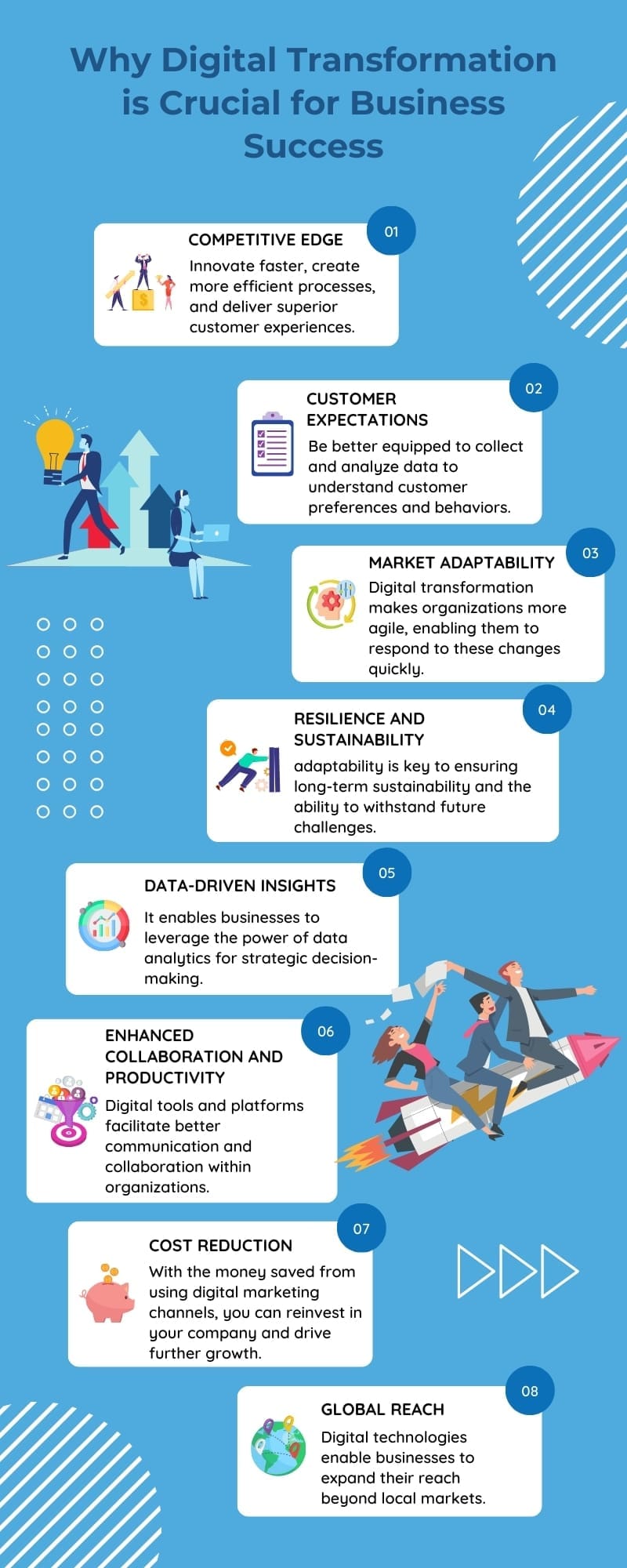
“Change is the only constant in life.” This timeless quote by Heraclitus captures the essence of digital transformation for businesses. Embracing change through digital transformation is essential to remain competitive in today’s digital age. However, it requires a fundamental shift in how your business operates and interacts with customers.
On this page, I’ll walk you through the digital transformation process, share real-world examples of concepts in action, and provide step-by-step instructions for developing your own personalized digital transformation strategy.
The Core of Digital Transformation Explained
Because the phrase “digital transformation” is used so much and in so many different contexts, it can be difficult to know exactly what it means and how it applies to your business. Let’s dig into this aspect first so we can build on it as we go.
Defining Digital Transformation and its Scope
Digital transformation refers to the way businesses integrate digital technology into all areas of operations. It’s more than just a technology upgrade or digitization of current processes. It’s a cultural shift in which organizations continuously challenge the status quo and experiment. This transformation helps businesses improve efficiency, enhance customer experience, and innovate in services and products.
For instance, a small retail business transitioning from a traditional brick-and-mortar model to an online e-commerce platform, while also utilizing social media for marketing and customer service, is undergoing digital transformation. Similarly, a local restaurant implementing an online ordering system or a mobile app for table reservations is embracing digital technology to improve customer convenience and operational efficiency.
The key is not just adopting new technologies but doing so in a way that transforms business practices, enhances customer experiences, and drives sustainable growth.
What is a Digital Transformation Strategy?

A digital transformation strategy is a comprehensive roadmap or plan that outlines how a business intends to leverage digital technologies to change its operational processes, products, and customer experiences to meet business objectives and respond to market demands. This strategy is not solely focused on adopting new technologies but encompasses a holistic approach to reshaping the organization’s culture, workflow, and customer interactions to drive growth, efficiency, and innovation.
A well-crafted digital transformation strategy includes several key components, as outlined below.
- Vision and Objectives: Clearly defining the end goals of the transformation, such as improving customer satisfaction, increasing operational efficiency, or entering new markets.
- Assessment of Current Capabilities: Evaluating the existing technology infrastructure, skills of the workforce, and business processes to identify gaps that digital technologies can fill.
- Technology Investment: Determining which technologies (e.g., cloud computing, artificial intelligence, big data analytics, mobile solutions) will best support the transformation goals and designing a roadmap for their implementation.
- Cultural Change: Promoting a culture that supports experimentation, agility, and digital literacy among all employees.
- Customer Focus: Prioritizing enhancements in customer experience through digital channels, ensuring that changes are aligned with customer needs and preferences.
- Data and Analytics: Leveraging data analytics to gain insights into business performance, customer behavior, and market trends to make informed decisions.
- Security and Compliance: Ensuring that digital solutions adhere to relevant security standards and regulatory requirements to protect sensitive information.
For example, a small manufacturing company might develop a digital transformation strategy that includes implementing an Internet of Things (IoT) solution to monitor and optimize their production processes, adopting a cloud-based CRM (Customer Relationship Management) system to improve customer interactions, and training their staff on data analysis tools to make better-informed decisions.
The success of a digital transformation strategy lies in its execution, which requires strong leadership, cross-functional collaboration, and ongoing evaluation to adapt to changing circumstances and technological advancements.
The Role of Digital Technology in Business Evolution

Digital technology plays an essential role in the evolution of businesses by enabling them to innovate, adapt, and thrive in an increasingly digital world. The way Shopify allows e-commerce brands to launch a storefront quickly and efficiently is a prime example. Restaurants using digital ordering and delivery services to expand their customer base is another. We also see professional services firms utilizing cloud-based software for project management and collaboration.
These developments are so crucial to the evolution of businesses that governments are supporting innovation through initiatives like the Canada Digital Adoption Program and offering the support needed to leverage digital technology for operational excellence and competitive advantage.
Let’s take a quick look at the mechanisms behind how digital technology is influencing business evolution today.
Operational Efficiency
Digital technologies streamline business processes, reduce manual tasks, and improve efficiency. For example, cloud computing allows businesses to store and access data remotely, enabling employees to work collaboratively from anywhere, while automation tools can handle repetitive tasks, freeing up people for more strategic activities.
Customer Experience
Digital solutions enable businesses to offer personalized and convenient experiences to customers. E-commerce platforms, mobile apps, and social media facilitate seamless interaction and transactions, allowing businesses to reach a wider audience and understand their preferences through data analytics.
Innovation
Digital technology is a catalyst for developing new products and services or enhancing existing ones. For instance, the use of artificial intelligence (AI) and machine learning can lead to the creation of intelligent products and services that adapt to user needs, opening new markets and opportunities.
Data-Driven Decision Making
The ability to collect, analyze, and act on data is a significant advantage provided by digital technology. Businesses can gain insights into operational performance, market trends, and customer behavior, leading to more informed decisions and strategies.
Market Expansion
Digital platforms break down geographical barriers, allowing businesses of all sizes to access global markets with relatively low investment. Digital marketing and social media can help you build brand awareness and reach potential customers wherever they may be.
Agility and Resilience
Digital technologies enable businesses to be more agile and responsive to market changes. Cloud-based tools and services can be scaled up or down as needed, and digital communication tools support rapid responses to customer inquiries and market demands.
Security and Compliance
As businesses embrace digital technologies, they also need to invest in cybersecurity to protect sensitive information and ensure compliance with data protection regulations. This is crucial for maintaining customer trust and avoiding legal and financial repercussions.
COVID-19 Accelerated the Digital Shift
The COVID-19 pandemic has served as a significant catalyst for digital transformation across various industries, accelerating the shift to digital operations and services at an unprecedented rate. This acceleration was driven by the need to adapt to new challenges such as remote work, social distancing, and changing consumer behaviors. The influence of COVID-19 on the digital shift can be observed in several key areas.
Remote Work
With lockdowns and social distancing measures in place, businesses rapidly adopted digital tools to enable remote work. Video conferencing software, cloud services, and collaboration platforms became essential, ensuring business continuity by allowing employees to work from home efficiently.
E-commerce and Online Services
Consumer behavior shifted dramatically towards online shopping as physical stores closed or faced restrictions. This shift forced businesses, even those previously with minimal online presence, to adopt e-commerce solutions and enhance their digital channels to reach customers. Restaurants, retail stores, and service providers accelerated their use of online ordering, delivery apps, and virtual consultations to meet customer needs.
Digital Payment Methods
The pandemic accelerated the adoption of contactless payments and digital financial services. Businesses and consumers alike sought to minimize physical contact, leading to a surge in the use of mobile wallets, online banking, and digital currencies.
Cybersecurity and Data Privacy
As businesses and individuals increased their reliance on digital platforms, the importance of cybersecurity and data privacy became more pronounced. Organizations accelerated their digital security measures to protect sensitive information against the backdrop of a rising threat landscape exacerbated by the pandemic.
Supply Chain and Logistics
The disruption of global supply chains highlighted the need for more resilient and flexible digital solutions. Businesses invested in digital technologies like IoT, AI, and blockchain to improve supply chain visibility, forecasting, and efficiency.
Real-World Benefits and Advantages for Businesses
Businesses that undergo digital transformation reap numerous benefits and advantages.
Increased Operational Efficiency
Digital tools automate routine tasks, streamline workflows, and improve communication among teams can boost productivity by 25 percent, McKinsey reports. Cloud-based project management software comes to mind as a key example here. It enables teams to collaborate in real-time from anywhere, reducing project completion times and increasing productivity.
Enhanced Customer Experience
Digital transformation allows you to offer personalized and seamless customer experiences across multiple channels. We see this all the time in practice when retailers use data analytics to provide tailored recommendations and offers to us, improving satisfaction and loyalty.
Data-Driven Insights
By leveraging big data and analytics, you can gain valuable insights into customer behavior, market trends, and operational performance. This enables informed decision-making and strategic planning. I often make reference to this in digital marketing and how you can use your analytics to boost satisfaction, streamline customer journeys, and boost sales. Another example is how manufacturing companies and warehouses often use IoT sensors to monitor equipment performance and predict maintenance needs, reducing downtime and costs.
Increased Agility and Innovation
Digital transformation encourages a culture of innovation, enabling businesses to respond quickly to market changes and customer needs. Digital platforms facilitate rapid prototyping and testing of new products and services, accelerating innovation cycles.
Expanded Market Reach
Online platforms and e-commerce enable businesses to reach a global audience without the need for a physical presence. Even small local businesses can sell products and services worldwide, opening up new revenue streams.
Improved Security and Compliance
Digital transformation includes upgrading cybersecurity measures and ensuring compliance with data protection regulations. This not only protects your business from cyber threats but also builds trust with customers and partners.
Sustainability and Cost Reduction
Digital processes are often more environmentally friendly and cost-effective than traditional methods. For instance, moving to digital invoicing reduces paper use and processing costs. Energy savings are also significant when businesses adopt smart building technologies and cloud computing.
Workforce Empowerment
Digital tools and technologies empower employees to work more effectively, providing them with access to information and resources to make better decisions and improve their skill sets. For example, AI-powered analytics tools can help sales teams identify, classify, and assign leads more efficiently, enhancing productivity.
Business Model Innovation
Digital transformation can lead to the creation of new business models. Subscription-based services, on-demand platforms, and freemium models are examples of how businesses have innovated to generate new revenue streams and improve customer engagement. Netflix’s pivot from DVD rentals to operating as a streaming service is an example of this in action. The company also leverages its data to personalize content recommendations to improve customer service and satisfaction.
Why Digital Transformation is Crucial for Business Success
Digital transformation is crucial for business success for several reasons, underscoring its importance beyond mere technology adoption to a fundamental reimagining of business operations and strategy.
Competitive Edge

In today’s fast-paced business environment, digital transformation offers companies a significant competitive advantage. Businesses that leverage digital technologies can innovate faster, create more efficient processes, and deliver superior customer experiences. This adaptability is crucial for staying ahead of competitors and meeting consumers’ evolving expectations.
Customer Expectations
Modern consumers expect personalized, seamless, and on-demand services, which can only be delivered through digital means. Companies that undergo digital transformation are better equipped to collect and analyze data to understand customer preferences and behaviors, allowing them to tailor their offerings and interactions to meet these expectations.
Market Adaptability
The business landscape is constantly changing, influenced by technological advancements, market trends, and consumer behaviors. Digital transformation makes organizations more agile, enabling them to respond to these changes quickly. By embracing a culture of innovation and continuous improvement, businesses can pivot their strategies and operations to seize new opportunities.
Resilience and Sustainability
The COVID-19 pandemic highlighted the need for businesses to be resilient in the face of disruptions. Digital transformation enhances a company’s resilience by allowing for remote work, diversifying supply chains, and offering digital products and services. This adaptability is key to ensuring long-term sustainability and the ability to withstand future challenges.
Data-Driven Insights
Digital transformation enables businesses to leverage the power of data analytics for strategic decision-making. By collecting and analyzing data from various sources, companies can gain insights into operational inefficiencies, market trends, and customer preferences, leading to more informed decisions that drive growth and profitability. This is no doubt why businesses that are considered to have higher digital transformation maturity report above-average profit compared to their peers 28 percent more often than low-maturity companies, per Deloitte research.
Enhanced Collaboration and Productivity
Digital tools and platforms facilitate better communication and collaboration within organizations, breaking down silos and improving efficiency. Employees can share information easily and work together more effectively, boosting productivity and innovation.
Cost Reduction
Over time, digital transformation can lead to significant cost savings. Automation of routine tasks reduces labor costs, cloud computing reduces IT expenses, and digital marketing can be more cost-effective than traditional methods. These savings can then be reinvested into your business to drive further growth.
Global Reach
Digital technologies enable businesses to expand their reach beyond local markets, accessing global customers through e-commerce, social media, and digital marketing. This expansion can open new revenue streams and diversify the customer base, reducing dependence on local markets.
Developing a Strategic Approach to Digital Transformation
Successful digital transformation requires strategic planning, careful execution, and a willingness to adapt and learn. By leveraging digital technologies, your businesses can not only survive but thrive in today’s digital economy.
Creating an Effective Digital Transformation Strategy
Creating an effective digital transformation strategy involves several critical steps tailored to your business’s unique challenges and opportunities. By focusing on strategic planning and execution, your business can leverage digital technologies to enhance operations, customer experience, and market competitiveness.
Define Your Vision and Objectives
Start by identifying what you want to achieve with digital transformation. This could be enhancing customer experience, improving operational efficiency, expanding into new markets, or increasing profitability. Your vision should align with your overall business goals and address specific challenges or opportunities in your industry.
Assess Your Current Digital Maturity
Evaluate your current technology infrastructure, digital skills, and processes to understand where you stand and what gaps exist. This assessment should cover your IT systems, software applications, data management practices, and employee digital literacy. Understanding your starting point is crucial for planning your transformation journey.
Identify Key Areas for Digital Adoption
Based on your objectives and current state assessment, pinpoint the key areas where digital technologies can have the most significant impact. This might include CRM, e-commerce, digital marketing, process automation, data analytics, or cybersecurity.
Develop a Roadmap
Create a detailed plan that outlines the steps needed to achieve your digital transformation objectives. This roadmap should include specific projects, timelines, required investments, and responsible teams or individuals. Considering your budget and resources, prioritize initiatives based on feasibility and potential impact.
Engage Your Team
Digital transformation is as much about people as it is about technology. Engage your employees early in the process, communicating the vision and benefits of the transformation. Provide training and support to foster a culture of innovation and agility and develop their digital skills.
Select the Right Technologies
Choose technologies that best align with your objectives and fit your budget. Cloud-based solutions can be particularly beneficial, offering scalability, flexibility, and cost-effectiveness. Focus on user-friendly, integrated tools that can grow with your business.
Implement in Phases
Approach the implementation in manageable phases, starting with quick wins that can deliver immediate benefits. This phased approach helps build momentum and confidence, allowing you to learn and adjust your strategy as you go.
Monitor, Measure, and Adjust
Establish key performance indicators (KPIs) to monitor progress and measure the impact of your initiatives. Regularly review these metrics to assess what’s working and where adjustments may be needed. Be prepared to pivot based on feedback and changing conditions.
Focus on Customer Experience
Throughout the transformation process, keep the customer experience at the forefront. Use digital tools to gather customer feedback, personalize interactions, and deliver superior service. Happy customers are crucial to driving growth and success.
Ensure Data Security and Compliance
As you increase your digital activities, protecting your business and customer data is crucial. Invest in cybersecurity and ensure compliance with relevant data protection regulations to build trust and avoid legal issues.
Measuring ROI and Setting Up KPIs for Digital Initiatives
Measuring the return on investment (ROI) and setting up KPIs are critical for evaluating the success of digital initiatives. These metrics help to understand the impact of digital transformation efforts, guiding decision-making and strategy adjustments.
Define Clear Objectives for Each Initiative
Start by outlining specific, measurable objectives for each digital initiative. Whether it’s increasing online sales, improving customer satisfaction, or enhancing operational efficiency, having clear goals will help determine the right KPIs to track.
Identify Relevant KPIs
For each objective, identify KPIs that accurately reflect progress and success. These should be quantifiable metrics that are directly tied to your digital initiatives. For example:
- For e-commerce sales growth, KPIs might include online revenue increase, conversion rate, and average order value.
- For customer engagement, KPIs could be social media interactions, website traffic, and email marketing open rates.
- For operational efficiency, consider process completion times, automation savings, or cloud storage costs.
Set Up Measurement Tools and Processes
Implement tools and processes to track these KPIs effectively. Many digital platforms come with built-in analytics, but you may also need to invest in additional tools for comprehensive tracking. Ensure that you can collect and analyze data accurately and in a timely manner.
Calculate ROI
To calculate ROI, quantify the financial gains from your digital initiatives and subtract the costs associated with implementing and maintaining them. Consider both direct and indirect benefits, including increased sales, cost savings, and improved customer satisfaction.
Regularly Review KPIs and ROI
Make it a regular practice to review your KPIs and calculate ROI. This shows the immediate impact of your digital initiatives and helps you understand long-term trends and areas for improvement.
Adjust Your Strategies Based on Insights
Use the insights gained from your KPIs and ROI calculations to make informed decisions about adjusting your digital strategies. If specific initiatives are not performing as expected, investigate why and consider reallocating resources to more successful areas.
Communicate Results
Share the results of your digital initiatives with your team and stakeholders. Highlighting successes can boost morale and support for ongoing digital transformation efforts, while openly discussing challenges can foster a culture of continuous improvement.
Consider Customer Feedback and Market Changes
Incorporate customer feedback and market trends into your evaluation process. These insights can provide valuable context for your KPIs and ROI, helping you refine your digital initiatives to meet customer needs better and adapt to the competitive landscape.
Balancing Technology and Cultural Change in Digital Strategy
Finding the right equilibrium between adopting new technologies and cultivating a culture that embraces change can be a significant hurdle in digital transformation.
Creating Balance is Crucial
Balancing technology and cultural change is essential in a digital strategy because the success of digital transformation is more than the adoption of new technologies. It involves a fundamental shift in how a business operates, thinks, and engages its stakeholders.
Technology Adoption Requires Cultural Buy-in
Implementing new technologies isn’t just a logistical challenge; it’s a people challenge. For technology adoption to be successful, employees at all levels must understand the benefits, feel confident using new tools, and be willing to adapt their workflows. A culture that embraces change, values continuous learning, and encourages innovation is essential for this.
Cultural Change Drives Innovation
A culture that fosters experimentation, agility, and digital literacy can significantly enhance the impact of technological investments. Businesses that encourage innovative thinking and are not afraid to fail are more likely to discover new opportunities for growth and efficiency through digital technologies.
Sustaining Digital Transformation
Sustaining digital transformation efforts requires ongoing engagement, collaboration, and adaptation. A supportive culture ensures that employees remain motivated and engaged with the digital strategy, even as business goals and technologies evolve.
How to Create Balance During Your Digital Transformation
Balancing technology and cultural change is about creating an ecosystem where digital tools and a supportive culture coexist and reinforce each other. By addressing this balance, you can maximize the benefits of your digital strategy, ensuring a smoother transition and a stronger competitive position in the digital age.
Develop a Clear Vision and Communicate It
Leaders should articulate a clear vision for what the digital transformation is meant to achieve and how it aligns with the company’s values and goals. This communication should emphasize the role of every employee in this journey, fostering a sense of ownership and inclusion.
Foster a Culture of Learning and Adaptability
Cultivate an environment that encourages curiosity, learning, and adaptability. This can be achieved through regular training sessions and workshops and by providing access to self-learning resources. Recognize and reward efforts to embrace new technologies and innovate processes.
Involve Employees in the Transformation Process
Engage employees in decision-making processes related to digital initiatives. Soliciting their input and feedback makes them feel valued and helps identify potential challenges and opportunities from different perspectives.
Lead by Example
Leadership should demonstrate a commitment to digital transformation and cultural change. By using new technologies and adopting new ways of working themselves, leaders can set a precedent for the rest of the organization.
Celebrate Successes and Learn from Failures
Recognize and celebrate milestones and successes in the digital transformation journey. Equally important is to adopt a constructive approach to failures or setbacks, treating them as learning opportunities rather than reasons for punishment.
Address Resistance Proactively
Identify and address resistance to change proactively. Understand employees’ concerns and provide the necessary support to help them adapt. This may involve one-on-one mentoring, additional training, or even redefining job roles to better align with the new digital strategy.
Promote Collaboration and Cross-Functional Teams
Encourage collaboration between departments and create cross-functional teams to work on digital initiatives. This not only fosters a sense of unity but also helps in breaking down silos, ensuring a more cohesive approach to digital transformation.
Navigating Future Trends and Innovations in Digital Transformation
Staying on top of digital transformation trends is crucial for crafting strategies that are resilient, forward-thinking, and responsive to the ever-evolving digital landscape. Adapting to these trends requires a blend of technological investment and strategic planning, ensuring businesses remain competitive and relevant in the digital age.

Key Trends Shaping the Future of Digital Transformation
Key trends are deeply influenced by technological advancements, changing consumer expectations, and the global economic landscape. These trends drive innovation and challenge you to adapt and evolve. Let’s quickly examine some crucial trends impacting the digital transformation landscape.
Artificial Intelligence and Machine Learning (ML)
AI and ML are at the forefront of digital transformation, enabling you to automate processes, gain insights from data, and enhance decision-making. AI-driven analytics can predict customer behavior, optimize operations, and personalize customer experiences. As these technologies become more accessible, their adoption will continue to rise, driving efficiency and innovation.
Internet of Things
IoT technology connects physical devices to the internet, collecting and exchanging data. This connectivity enables you to improve efficiency, enhance data collection, and offer new services. For instance, in manufacturing, IoT devices can monitor equipment health to predict failures before they occur, reducing downtime.
5G Connectivity
The rollout of 5G networks promises to revolutionize digital transformation by offering significantly faster speeds and more reliable connections. This enhancement in connectivity will enable more robust IoT applications, facilitate real-time data analytics, and improve the mobility and flexibility of digital solutions.
Cybersecurity Mesh
As digital transformation expands, so does the attack surface for cyber threats. Cybersecurity mesh is a flexible, modular approach integrating various security services around a centralized policy enforcement framework. This approach allows you to secure all assets, regardless of location, effectively addressing the security challenges of distributed digital infrastructures.
Hybrid and Remote Work Models
The COVID-19 pandemic accelerated the adoption of remote work, and now, hybrid models are becoming the norm. This shift requires digital tools that support collaboration, productivity, and security for remote teams.
Digital Trust and Privacy
As consumers become more aware of their digital rights, businesses must prioritize trust and privacy within their digital strategies. Implementing transparent data practices, investing in secure infrastructure, and ensuring compliance with privacy regulations are critical for maintaining customer trust and loyalty.
Sustainable and Socially Responsible Digital Transformation
There’s an increasing focus on how digital transformation can support sustainability and social responsibility goals. This includes using technology to reduce carbon footprints, improve resource efficiency, and address social inequalities. Businesses incorporating these considerations into their digital strategies will likely gain a competitive edge.
Personalization and Customer Experience
Data analytics and AI advancements enable businesses to offer unprecedented levels of personalization. Tailoring products, services, and interactions to individual customer preferences improves the customer experience and drives loyalty.
Edge Computing
Edge computing processes data closer to where it’s generated (at the “edge” of the network), reducing latency and bandwidth use. This trend is crucial for real-time applications, IoT devices, and situations where rapid processing is essential.
Preparing for the Next Wave of Innovations
Prepare for the next wave of digital innovations by adopting a proactive and strategic approach to technology and market trends. This preparation positions you to capitalize on new opportunities and ensures resilience against disruptions.
Embrace a Culture of Continuous Learning
Foster a culture that values continuous learning and adaptability. Encourage employees to stay informed about emerging technologies and industry trends through training, workshops, and online courses. This knowledge empowers the team to innovate and adapt to new digital tools and processes.
Stay Informed on Technological Advances
Regularly monitor advancements in technology relevant to your industry. Follow industry news, attend conferences, and participate in online communities. This awareness can help you identify which innovations are most applicable to your business and when to adopt them.
Develop a Flexible Digital Strategy
Create a digital strategy that is flexible and can evolve with technological advancements. This strategy should include regular reviews and updates based on the latest digital trends, competitive landscape, and customer expectations. Being agile allows you to pivot or adapt your approach as new opportunities or challenges arise.
Invest in Scalable Technologies
Choose technology solutions that are scalable and can grow with your business. Cloud-based services, for example, allow you to increase capacity or add features as needed easily. Investing in scalable technologies ensures your business can quickly adapt to new demands without significant overhauls.
Focus on Data and Analytics
Leverage data to gain insights into your business operations, customer behavior, and market trends. This data-driven approach can inform decision-making, helping you tailor products and services, optimize operations, and predict future trends. Implement tools that can analyze data in real-time, providing actionable insights to stay ahead of the curve.
Prioritize Cybersecurity
As digital technologies evolve, so do cybersecurity threats. Implement robust security to protect your business and customer data. This includes regular security audits, employee training on security best practices, and investing in up-to-date security technologies. A strong focus on cybersecurity builds customer trust and protects against potentially devastating breaches.
Build Partnerships and Collaborations
Form partnerships with technology providers, industry peers, and other stakeholders. Collaborations can offer access to new technologies, skills, and markets. By building a network of partners, you can share risks, costs, and learnings, making navigating the complexities of digital innovation easier.
Adopt a Customer-Centric Approach
Keep your customers at the heart of your digital transformation efforts. Use digital technologies to enhance the customer experience through personalized services, seamless online interactions, or improved product quality. Listening to customer feedback and analyzing behavior can guide your innovation efforts in directions that add the most value.
Plan for Digital Resilience
Ensure your digital strategy includes plans for data backup, disaster recovery, and business continuity. This resilience planning helps your business withstand and quickly recover from technical failures, cyberattacks, or other disruptions.
Experiment
Adopt a mindset of experimentation, allowing for testing new technologies and approaches on a small scale before full implementation. This process helps mitigate risks and learn from failures, gradually integrating successful innovations into your business operations.
Begin Your Digital Transformation Journey
In today’s fast-changing digital world, digital transformation is critical for businesses to grow, become more efficient, and connect better with customers. It’s about more than just new tech—it’s about reshaping how businesses work from the ground up. This means taking smart steps to use digital tools in a way that matches your goals, encourages ongoing learning, and adapts to changes quickly. Embracing trends like artificial intelligence, the Internet of Things, and 5G can open up new opportunities. By focusing on strong digital strategies, cybersecurity, understanding data, and putting customers first, your businesses can thrive in the digital age. Let’s look ahead, ready to innovate and transform, showing that with the right approach, the digital future is full of possibilities for businesses of all sizes.
Let Me Know How I Can Help
As a digital marketing consultant with a background in business, I spend time getting to know the companies I serve and how they operate at a deep level. By evaluating their processes and use of technology, I’m able to pinpoint areas of opportunity in their digital transformation journey that we can address as part of their overall roadmap to strengthen the organization as it scales. My approach works well with large corporations and Fortune 100 companies, though my true passion lies in helping small and mid-sized businesses make these transitions and experience transformational growth. If this approach resonates with you, let’s have a discussion about where your business stands now and where you’d like it to go. Contact me to schedule a time to talk.





































































